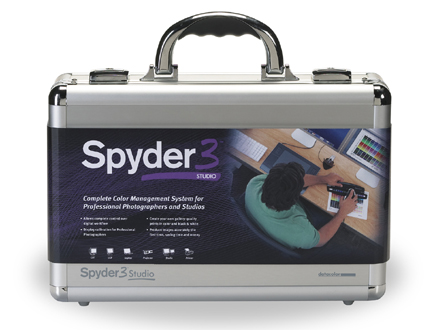PMA 08; Color Management
Color management isn't one of those topics that tend to get the heart racing with excitement, although the lack of it has probably caused more than a few panic attacks. We've seen steady improvements in color calibration hardware and software over the past few years and it's clear that color management is becoming much more mainstream than ever as digital photographers recognize the importance of this key part of the workflow.
Datacolor
The past year has been one of consolidation in the industry with X-Rite purchasing
Pantone, leaving Datacolor as the other major vendor with calibration products
for the consumer. At PMA, Datacolor was showing the latest version of the Spyder3
monitor and printer calibration devices. Although the hardware isn't new
to PMA, updates to the software have increased performance and made it easier
to get consistent results. The Spyder line is broken down into monitor calibration
with the Spyder3 colorimeter, which is available in Pro and Elite configurations,
and the Datacolor 1005 spectrocolorimeter. The hardware is the same on the monitor
side, but the Elite package adds the ability to set custom color temperatures,
unlimited numbers of gamma choices, a custom black and white luminance control,
and advanced features like custom curves, L* workflows, and digital projector
profiling. The Spyder3Pro lists for $169, and the Spyder3Elite lists for $279.
 |
The Spyder2express is also available as a low-cost solution. Based on the
previous generation of hardware, and using very simple wizard-driven software,
the $79 express model is a good entry point.
For the full package of monitor and printer calibration and profiling, the Spyder3Studio
combines the Spyder3Elite package with the Spyder3Print. This adds the Datacolor
spectrocolorimeter for measuring printer charts, along with an application to
generate, measure, and fine-tune printer profiles. One unique feature is the
extended gray target. Having used this to generate printer profiles, I can say
that it works extremely well. There is a world of debate over whether a spectrocolorimeter,
like that used by Datacolor, is equal to the performance of a spectrophotometer,
like the ones used by X-Rite, but the only thing that matters to most of us
is the final quality. Here, the Datacolor product stands on its own and does
a wonderful job. The suggested list price for the Spyder3Studio is $599. If
you already have a monitor calibration system, you can buy just the print side
of the product, Spyder3Print, for $499.
 |
X-Rite
Don't look now, but you're about to have a Munki on your back. Or,
X-Rite hopes, at least on your monitor and printer charts. Coming out in two
different versions--one for photographers, the other for graphic designers--the
X-Rite ColorMunki is a compact spectrophotometer that looks a little like an
oversized measuring tape. The same device is used to calibrate your monitor
and create printer profiles, which is an advantage in that you only need to
have a single device (one less thing for me to track in a crowded studio).
 |
The ColorMunki Photo is the most interesting for the average digital photographer
and includes software for calibrating your displays as well as generating printer
profiles using a very interesting new measurement chart. Currently, the TC9.18
is the most popular chart in use. With 918 color patches, it can take a while
to read. The new technology uses a much smaller chart that X-Rite claims can
be read in less than one minute with no loss of color fidelity. The charts can
be optimized for different tones, such as skin or black and white printing,
and generates both RGB and CMYK profiles. ColorMunki Photo also supports digital
projector profiling, ambient light measurement, and spot color reading from
any source, which can then be used in your image-editing software for an exact
color match.

































